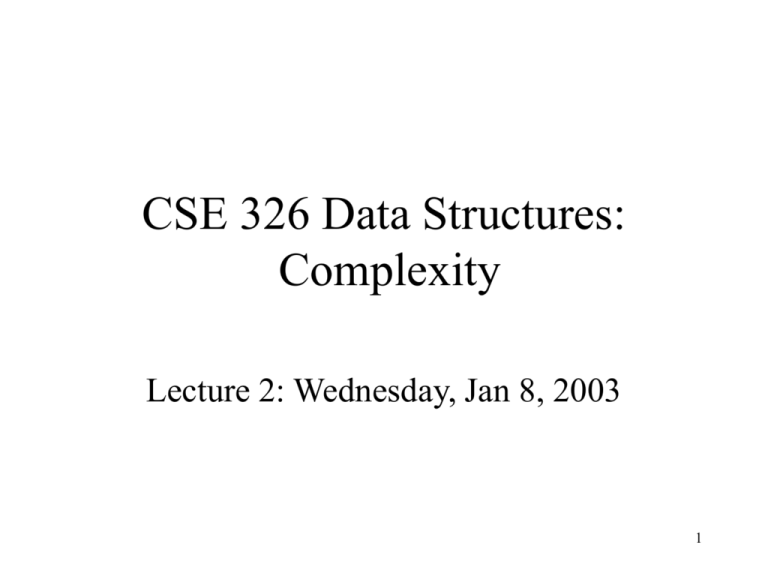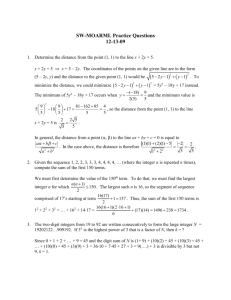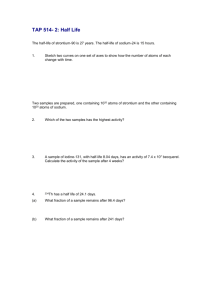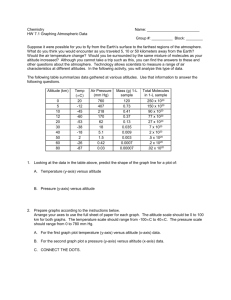lecture02b
advertisement

CSE 326 Data Structures:
Complexity
Lecture 2: Wednesday, Jan 8, 2003
1
Overview of the Quarter
•
•
•
•
•
•
•
•
•
•
Complexity and analysis of algorithms
List-like data structures
Search trees
Priority queues
Hash tables
Midterm
Sorting
around here
Disjoint sets
Graph algorithms
Algorithm design
Advanced topics
2
Complexity and analysis of
algorithms
• Weiss Chapters 1 and 2
• Additional material
– Cormen,Leiserson,Rivest – on reserve at Eng.
library
– Graphical analysis
– Amortized analysis
3
Program Analysis
• Correctness
– Testing
– Proofs of correctness
• Efficiency
– Asymptotic complexity - how running times
scales as function of size of input
4
Proving Programs Correct
• Often takes the form of an inductive proof
• Example: summing an array
int sum(int v[], int n)
{
if (n==0) return 0;
else return v[n-1]+sum(v,n-1);
}
What are the parts of an inductive proof?
5
Inductive Proof of Correctness
int sum(int v[], int n)
{
if (n==0) return 0;
else return v[n-1]+sum(v,n-1);
}
Theorem: sum(v,n) correctly returns sum of 1st n elements of
array v for any n.
Basis Step: Program is correct for n=0; returns 0.
Inductive Hypothesis (n=k): Assume sum(v,k) returns sum of
first k elements of v.
Inductive Step (n=k+1): sum(v,k+1) returns v[k]+sum(v,k),
which is the same of the first k+1 elements of v.
6
Inductive Proof of Correctness
Binary search in a sorted
array:
int find(int x, int v[], int n)
{ int left = -1;
int right = n;
while (left+1 < right) {
int m = (left+right) / 2;
if (x == v[m]) return m;
if (x < v[m]) right = m;
else left = m;
}
return –1; /* not found */
v[0]v[1] ... v[n-1]
Given x,
find m s.t. x=v[m]
Exercise 1:
proof that it is correct
}
Exercise 2: compute m, k s.t.
v[m-1] < x = v[m] = v[m+1] = ... = v[k] < v[k+1]
7
Proof by Contradiction
• Assume negation of goal, show this
leads to a contradiction
• Example: there is no program that
solves the “halting problem”
– Determines if any other program runs
forever or not
Alan Turing, 1937
8
Program NonConformist (Program P)
If ( HALT(P) = “never halts” ) Then
Halt
Else
Do While (1 > 0)
Print “Hello!”
End While
End If
End Program
• Does NonConformist(NonConformist) halt?
• Yes? That means
HALT(NonConformist) = “never halts”
• No? That means
HALT(NonConformist) = “halts”
9
Defining Efficiency
• Asymptotic Complexity - how running time
scales as function of size of input
• Two problems:
– What is the “input size” ?
– How do we express the running time ? (The
Big-O notation)
10
Input Size
• Usually: length (in characters) of input
• Sometimes: value of input (if it is a number)
• Which inputs?
– Worst case: tells us how good an algorithm works
– Best case: tells us how bad an algorithm works
– Average case: useful in practice, but there are
technical problems here (next)
11
Input Size
Average Case Analysis
• Assume inputs are randomly distributed according
to some “realistic” distribution
• Compute expected running time
E (T , n)
xInputs( n )
Prob ( x) RunTime( x)
• Drawbacks
– Often hard to define realistic random distributions
– Usually hard to perform math
12
Input Size
• Recall the function: find(x, v, n)
• Input size: n (the length of the array)
• T(n) = “running time for size n”
• But T(n) needs clarification:
– Worst case T(n): it runs in at most T(n) time for any x,v
– Best case T(n): it takes at least T(n) time for any x,v
– Average case T(n): average time over all v and x
13
Input Size
Amortized Analysis
• Instead of a single input, consider a sequence of
inputs:
– This is interesting when the running time on some input
depends on the result of processing previous inputs
• Worst case analysis over the sequence of inputs
• Determine average running time on this sequence
• Will illustrate in the next lecture
14
Definition of Order Notation
•
Upper bound:T(n) = O(f(n))
Big-O
Exist constants c and n’ such that
T(n) c f(n) for all n n’
•
Lower bound:T(n) = (g(n))
Omega
Exist constants c and n’ such that
T(n) c g(n) for all n n’
•
Tight bound: T(n) = (f(n))
Theta
When both hold:
T(n) = O(f(n))
T(n) = (f(n))
Other notations: o(f), (f) - see Cormen et al.
15
Example: Upper Bound
Claim: n 2 100n O (n 2 )
Proof: Must find c, n such that for all n n,
n 2 100n cn 2
Let's try setting c 2. Then
n 2 100n 2n 2
100n n 2
100 n
So we can set n 100 and reverse the steps above.
16
Using a Different Pair of Constants
Claim: n 2 100n O(n 2 )
Proof: Must find c, n such that for all n n,
n 100n cn
Let's try setting c 101. Then
2
2
n 100n 100n
2
2
n 100 101n (divide both sides by n)
100 100n
1 n
So we can set n 1 and reverse the steps above.17
Example: Lower Bound
Claim: n 2 100n (n 2 )
Proof: Must find c, n such that for all n n,
n 2 100n cn 2
Let's try setting c 1. Then
n 2 100n n 2
n0
So we can set n 0 and reverse the steps above.
Thus we can also conclude n 2 100n (n 2 )
18
Conventions of Order Notation
Order notation is not symmetric: write 2n 2 n O(n 2 )
but never O(n 2 ) 2n 2 n
The expression O( f (n)) O( g (n)) is equivalent to
f (n) O( g (n))
The expression ( f ( n)) ( g ( n)) is equivalent to
f (n) ( g (n))
The right-hand side is a "cruder" version of the left:
18n 2 O(n 2 ) O(n3 ) O(2n )
18n 2 (n 2 ) (n log n) (n)
19
Which Function Dominates?
f(n) =
g(n) =
n3
100n2 + 1000
+
2n2
n0.1
log n
n + 100n0.1
2n + 10 log n
5n5
n!
n-152n/100
1000n15
82log n
3n7 + 7n
Question to class: is f = O(g) ? Is g = O(f) ?
20
Race I
f(n)= n3+2n2 vs. g(n)=100n2+1000
21
Race II
n0.1
vs.
log n
22
Race III
n + 100n0.1
vs. 2n + 10 log n
23
Race IV
5n5
vs.
n!
24
Race V
n-152n/100
vs.
1000n15
25
Race VI
82log(n)
vs.
3n7 + 7n
26
16n log8 (10n ) 100n O(n log(n))
3
• Eliminate
low order
terms
• Eliminate
constant
coefficients
2
2
3
16n3 log8 (10n 2 ) 100n 2
16n3 log8 (10n 2 )
n3 log8 (10n 2 )
n3 log8 (10) log 8 ( n 2 )
n3 log8 (10) n3 log8 (n 2 )
n3 log8 (n 2 )
n3 2 log8 (n)
n3 log8 (n)
n3 log8 (2) log( n)
n3 log(n)
27
Common Names
Slowest Growth
constant:
O(1)
logarithmic:
O(log n)
linear:
O(n)
log-linear:
O(n log n)
quadratic:
O(n2)
exponential:
O(cn) . . .2
2
2
hyperexponential: O(2
)
(c is a constant > 1)
(a tower of n exponentials
Fastest Growth
Other names:
superlinear:
polynomial:
O(nc)
O(nc)
(c is a constant > 1)
(c is a constant > 0)
28
Sums and Recurrences
Often the function f(n) is not explicit but
expressed as:
• A sum, or
• A recurrence
Need to obtain analytical formula first
29
Sums
n(n 1)
f (n) 1 2 ... n i
O(n 2 )
2
i 1
n
n
f (n) 1 3 5 ... (2n 1) (2i 1) n 2 O(n 2 )
i 1
n
f (n) 1 2 ... n i 2
2
2
2
i 1
n(n 1)( 2n 1)
O(n 3 )
6
f (n) 13 23 ... n3 O(?)
n
f (n) 1 5 9 ... (4n 3) (4i 3) 4 O(??)
4
4
4
4
i 1
30
More Sums
3n1 1
f (n) 1 3 3 ... 3 3
O(3n )
3 1
i 1
n
2
n
i
Sometimes sums are easiest computed with integrals:
n1
1 1 1
1 n 1
f (n) ... 1 dx 1 ln( n) ln( 1) O(ln( n))
1 x
1 2 3
n i 1 i
n
n 1
1 1 1
1
1
1 1
f (n) 2 2 2 ... 2 2 1 2 dx 1 O(1)
1 x
1 2 3
n
1 n
i 1 i
31
Recurrences
• f(n) = 2f(n-1) + 1, f(0) = T
• Telescoping
f(n)+1 = 2(f(n-1)+1)
f(n-1)+1 = 2(f(n-2)+1)
f(n-2)+1 = 2(f(n-3)+1)
.....
f(1) + 1 = 2(f(0) + 1)
f(n)+1
2
22
2n-1
= 2n(f(0)+1) = 2n(T+1)
f(n) = 2n(T+1) - 1
32
Recurrences
• Fibonacci: f(n) = f(n-1)+f(n-2), f(0)=f(1)=1
try f(n) = A cn What is c ?
A cn = A cn-1 + A cn-2
c2 – c – 1 = 0
c1, 2
1 1 4 1 5
2
2
n
n
1 5
1 5
1 5
B
O
f (n) A
2
2
2
n
Constants A, B can be determined from f(0), f(1) – not
interesting for us for the Big O notation
33
Recurrences
• f(n) = f(n/2) + 1, f(1) = T
• Telescoping:
f(n) = f(n/2) + 1
f(n/2) = f(n/4) + 1
...
f(2) = f(1) + 1 = T + 1
f(n) = T + log n = O(log n)
34







